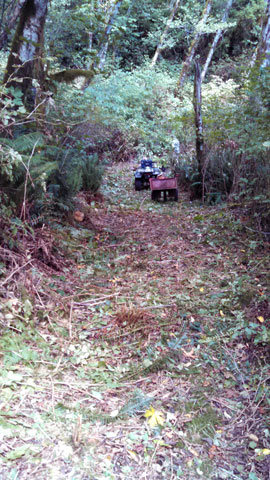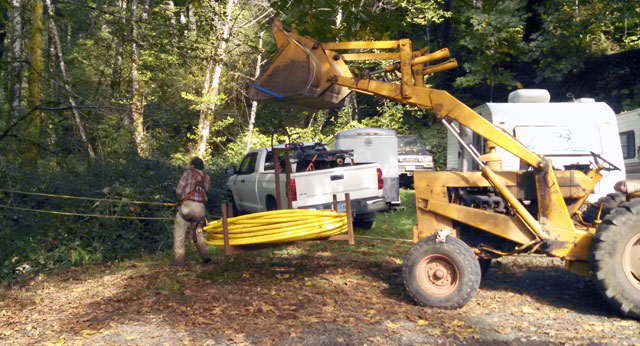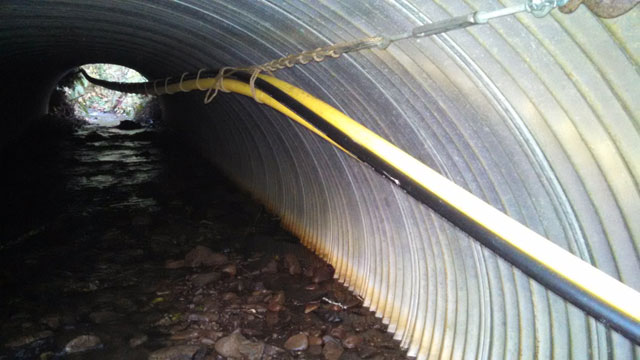Hydro Power 14
Not all of this project was sweat-free intellectual exercise. The next phase or two involves hard physical labor, not something of which I am overly fond.
My reliable and energetic friend Mark came down from Portland twice in Fall of 2015 to help route and install the yellow poly penstock pipes that I had purchased a year earlier. Mark is a veritable human dynamo, and he's seemingly unstoppable on any task.
 The first trip to Minerva, we spent two days clearing the old logging road that leads up the hill to my water source, and clearing a path down off the hill for the penstock pipes to bring water to the "powerhouse", an old, dilapidated milking shed at the entrance to my property.
The first trip to Minerva, we spent two days clearing the old logging road that leads up the hill to my water source, and clearing a path down off the hill for the penstock pipes to bring water to the "powerhouse", an old, dilapidated milking shed at the entrance to my property.
Because we would be making numerous trips up the hill hauling materials and equipment, I arranged to borrow my neighbor's 4x4 quad ATV, to which we coupled a small garden trailer I use around the property.
Using chain saws and gasoline powered brush cutters, we hacked and cut our way through the brush that had grown up in the road over the years. When I would walk up the hill to work on the water collection system, I would always carry a machete, keeping a path cleared. I would usually leave small fallen trees, stepping over them. This time, we basically scarified the entire quarter-mile roadway right down to the bare grass.
Once at the "spring" (I call it this, although the source of the water is higher up on the hill), we the began descending, clearing a path in the ravine that is the drainage for that waterway. This would be the route of the penstock, not the road we had just cleared.
About halfway down the mountain, we started leveling off, coming out of the ravine and traversing laterally on the hill side. The idea was that I wanted to come off the hill in a different drainage, crossing between the two at a kind of "saddle" in the topography. It was here that we ran into some of the most rugged terrain and obstacles of the clearing project. There were decades of thick brush growth, and many, many layers of small downed trees that had been growing, dying and falling to decay. In one place, which I have come to call "the bear woods", we had to crawl on our hands and knees in a tunnel of brush. This was obviously the haunt of woodsland creatures, and the entire area surrounding our work area was riven with bear trails. I was more then a little nervous, although our pussy black bears here would be no match for a running chainsaw.
I'm not really sure how, but in the end, we managed to scout and clear a path that was almost perfectly all downhill from the spring site. This is important, as moving water efficiently over distance depends on not having "hills and valleys" in the elevation of the pipe for air to collect in.
At the far downhill end of our journey, we exited the woods just above the country road, right across from the powerhouse. It was a steep 100 feet or so off the last of the hill and down to the road.
Two weeks later, in October of '15, Mark returned, bringing along his adult son, Chet. Mark and I are of modest physical build, but Chet is more of a 'dozer of a guy. Guess who was going to be harnessed to pull the pipes up the hill?
I had spent quite a lot of time trying to figure out the best method of uncoiling the yellow 1¼" poly pipe without arriving at a solid decision. It was thick walled and very stiff, and had been coiled up for years, getting it laid out flat was going to be a chore. The coils weighed 150 pounds each, so they weren't impossibly heavy, but they weren't light, either. Several thoughts came and passed, laying it out along the country road, unspooling it in my pasture in the sun, etc. Mark wanted to just cut the binding straps and play it out. I was concerned that it was kind of like a coiled spring, and if released improperly, would tangle itself in a giant mess when the tension was allowed to get loose.
In the end, I built a hanging, revolving turntable with caged sides out of scrap steel, supported by the loader on my backhoe.

We set up a rope and pulley, hanging a block from a big tree at the top of the first rise from the road. This area was so steep that it was impossible to climb it without using hands and feet, and getting the pipe up this first part would be the most difficult. Using the rope to haul the end of the pipe up first was a big help.
The pipe spool worked great, Mark and Chet were able to pull the first 500 feet up with a moderate amount of effort while I managed the unspooling. We needed to do this twice, once for each penstock. When each section of pipe had cleared the spool, I climbed the hill and the three of us would pull that section all the rest of the way to the top of the hill to the water source, about another 250 feet, before pulling up the next run.
The next two runs didn't have as far to go to meet the ends of the fist pipes up the hill, it went pretty quickly. We also put in a new run of 1" NSF certified poly pipe that would be the new supply for the domestic water for my residence. The old ¾" pipe was not "drinking water safe", and had been patched with sections of rusty metal pipe, etc.
It was necessary to get the new pipes on the opposite side of the county road. In these parts, that's what drainage culverts are for, and the county basically turns a blind eye towards the practice. In my case, the culvert I needed to go through was a special "salmon passage" culvert that had been installed to facilitate spawning fish accessing upstream reaches of the creek tributaries. The culvert is huge, and has had the bottom third or so covered in rock and native soil to emulate a natural streambed. It is possible to walk in the culvert in a hunched-over stance.
Because of the significance of this, I chose to not just place my pipes on the bed of the stream through the culvert, but instead, suspend the pipes from the roof of the metal shaft, so as to not draw any ire from the department of fish and wildlife, etc. So that the county couldn't get pissy about any atachments to their culvert that I might make, I used forged steel hooks and a turnbuckle to suspend the 3/8" EHF steel cable that served as the carrier wire for the pipes. Poly rope was used to lace the pipes to the wire.

At the ends of the culvert, where the pipes entered and exited, I disguised the pipes under native vegetation and by enclosing them in black drain pipe covered with a wired-in-place layer of tree moss. From a short distance, it's impossible to tell that anything is different in the culvert without actually getting down in the stream bed and looking in.
All that was left to do this season was to trench 50 feet or so from the culvert to my power house, a project that took less than a day thanks to my Case Model 60 trenching machine.
Original material ©1996-2025 Mr. Sharkey | All rights reserved
